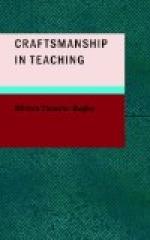Now what was the secret of the efficiency of this school? Not merely the fact that it had introduced certain types of content such as drawing, manual training, domestic science, dramatization, story work,—but also that it had not lost sight of the fundamental purpose of elementary education, but had so organized all of its studies that each played into the hands of the others, and that everything that was done had some definite and tangible relation to everything else. The manual training exercises and the mechanical drawing were exercises in arithmetic, but, let me remind you, there were other lessons, and formal lessons, in arithmetic as well. But the one exercise enlightened and made more meaningful the other. In the same way the story and dramatization were intimately related to the reading and the language, but there were formal lessons in reading and formal lessons in language. The geography illustrated nature study and employed language and arithmetic and drawing in its exercises. And so the whole structure was organized and coherent and unified, and what was taught in one class was utilized in another. There was no needless duplication, no needless or meaningless repetition. But repetition there was, over and over again, but always it was effective in still more firmly fixing the habits.
One would be an ingrate, indeed, if one failed to recognize the great good that an extreme reform movement may do. Some very precious increments of progress have resulted even from the most extreme and ridiculous reactions against the drill and formalism of the older schools. Let me briefly summarize these really substantial gains as I conceive them.
In the first place, we have come to recognize distinctly the importance of enlisting in the service of habit building the native instincts of the child. Up to a certain point nature provides for the fixing of useful responses, and we should be unwise not to make use of these tendencies. In the spontaneous activities of play, certain fundamental reactions are continually repeated until they reach the plane of absolute mechanism. In imitating the actions of others, adjustments are learned and made into habits without effort; in fact, the process of imitation, so far as it is instinctive, is a source of pure delight to the young child.




